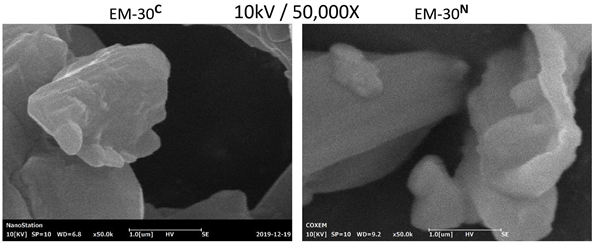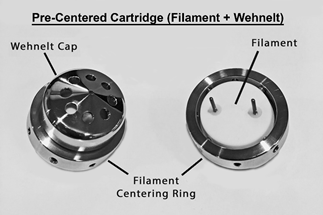The latest models of tabletop SEMs (TT-SEMs) feature a range of electron sources. Although a tungsten filament is used in a majority of TT-SEMs, certain models come with a Cerium Hexaboride (CeB6) source. To choose between these different systems, a customer needs to take into consideration these three aspects: performance, application, and economics.
Coxem’s TT-SEM product series provides both technologies: The EM-30N tungsten system and the EM-30C CeB6 system. As the sole manufacturer to supply both varieties of electron sources, Coxem is in an exclusive position to provide customers with impartial advice about selecting an ideal system to suit their needs.

Figure 1. A Tungsten cathode on the left, compared with a CeB6 cathode on the right. Image Credit: Coxem
The majority of desktop or tabletop SEMs (and generally most SEM systems) use a regular tungsten filament that is easily available from many microscopy consumable suppliers. Although tungsten has been the “workhorse” for a long time and is adequate for several applications, there are some situations where small spot size along with increased brightness (current at beam focus) enhances imaging, and for these applications, CeB6 proves to be an ideal choice.
The service life of CeB6 sources is usally approximately 10 times that of tungsten. However, they are a lot more expensive to change and maintain.
Performance
If a majority of the user’s imaging focuses on features or particles spanning from 1 to 10 µm or more, then a tungsten filament will fulfill those requirements. Their minimal cost of ownership and easy maintenance renders them the rational choice for regular imaging of comparatively low magnification. But if users essentially want features and particles smaller than 1 µm, then CeB6 may be the superior choice based on particle chemistry.

Figure 2. CeB6 (left image) vs Tungsten (right). For the best resolution of very small feature detail of low Z samples, CeB6 can offer superior imaging by using a lower kV eBeam. Image Credit: Coxem
Figure 2 shows how, at the same beam conditions, a CeB6 filament yields a more robust beam of electrons for stimulating the sample and, consequently, can generate a brighter image or one with a wider range of gray-scale than tungsten.
This enables the Coxem EM-30C to create vivid and bright images even at energies as low as 1–5 kV. In effect, when a 1–3 kV beam is used with the adjustable objective aperture and spot size, the EM-30C can produce stunning images in a high vacuum with an SE detector—even in the case of uncoated biological, non-conductive, or polymer samples. The tungsten EM-30N can realize comparable low kV operation but only at low magnification.
In complex conditions such as low Z samples, low kV, or very high magnification, users can anticipate better imaging with a CeB6 source. But quite similar to many things concerning SEM, there are compromises.
Cost
Tungsten filaments are comparatively economical (~$50–100) and easy to replace, particularly when they have a pre-centered design with a semi-disposable Wehnelt (refer to Figure 3). These filaments essentially last around 40–100 “beam on” hours and can be changed and aligned by a majority of the users in roughly 10 minutes.

Figure 3. Pre-centered filament cartridge. Image Credit: Coxem
By using tungsten filament to design advanced tabletop SEMs, it is also viable to clean the column and change condenser apertures, if required. This ensures that the yearly maintenance cost of owning such a system remains lower. In effect, yearly service maintenance agreements or service contracts are not normally necessary for owners of tungsten source TT-SEMs.
The CeB6 filaments are more costly (~$900) and usually last for around 1,500 hours before the need for a replacement arises. Although the considerably longer lifetime sounds attractive at first, users must keep in mind that the vacuum demands for CeB6 are ~2 orders of magnitude higher compared to the tungsten system (10−5 torr~ for a tungsten filament vs 10−7 torr for CeB6).
Therefore, the replacement and alignment of the electron source are more time-intensive and laborious, and occasionally necessitates service from the manufacturer for replacement. Furthermore, it is essential to keep the CeB6 systems powered at all times to avoid loss of vacuum. If a vacuum is lost in the column, it may require 4–12 hours based on the brand/model to realize the high vacuum required by these systems.
Similarly, the Turbo Molecular Pump (TMP) and fore-pump are run for many more hours, even during the idle time when the SEM is not used but still preserves vacuum. TMPs spin at 90,000 RPM and are one of the more expensive components to replace on an SEM.
The Coxem EM-30C helps deal with these challenges by featuring the design that enables the SEM to enter “idle mode” when not in use. Although the source is cooled down, the vacuum is preserved with the help of isolation valves. This enables a reduction in the wear on vacuum parts of the EM-30C and lowers power consumption. However, it is still able to “warm up” in about 30 minutes to a few hours from its idle mode.
By contrast, a tungsten source SEM system, such as the EM-30N, is similar to a light bulb—it can be switched on when needed and turned off when it is not in use.
Source: Coxem
| |
Tungsten
(EM-30N) |
CeB6
(EM-30C) |
| Imaging at Low e-Beam energy (<5 kV) |
|
✓ |
| Low Z (atomic weight) samples at Low kV |
|
✓ |
| Very High Magnification Imaging (>75,000X) |
|
✓ |
| Better Suitability for EBSD |
|
✓ |
| Faster Ready-to-Operate after Power Down |
✓ |
|
| More Suitable for Occasional SEM use |
✓ |
|
| Lower Cost of Operation / Ownership |
✓ |
|
| Lowest Annual Service Requirements |
✓ |
|
| User Replaceable e-Beam Source |
✓ |
✓ |
| Lowest Energy Usage (most “green” friendly) |
✓ |
|
Which Tabletop SEM is Best for Me?
As a potential buyer of a tabletop SEM, customers need to measure the cost advantages of tungsten against the performance advantages of CeB6. If they want to image particles and/or features smaller than 1–10 µm, need low kV imaging, and cost is not the primary issue, then CeB6 may be the ideal choice.
However, if customers are essentially seeking larger features, and acquisition and running costs are key, then a tungsten filament will match those needs at considerably lower costs.
If they are still not able to decide, a Coxem representative can provide more assistance and demonstrate both models to help customers make an informed decision.

This information has been sourced, reviewed and adapted from materials provided by COXEM Co. Ltd.
For more information on this source, please visit COXEM Co. Ltd.